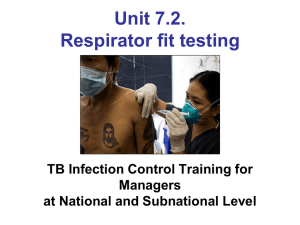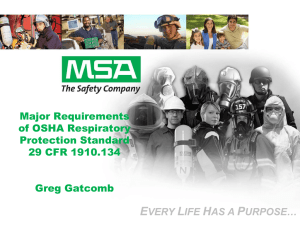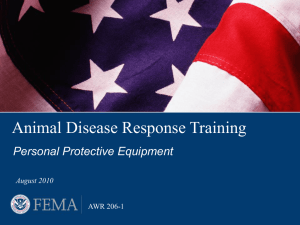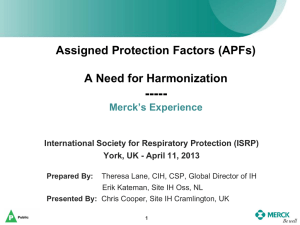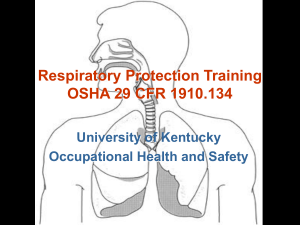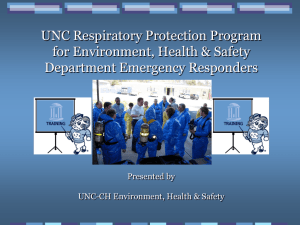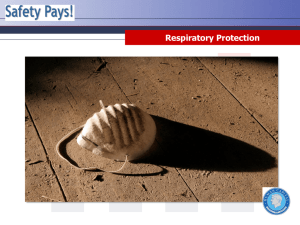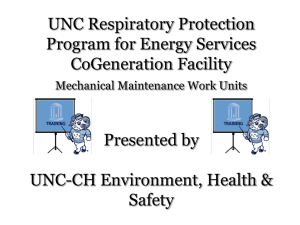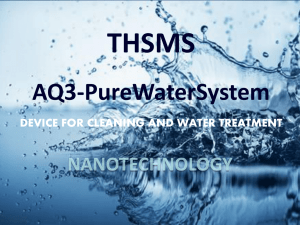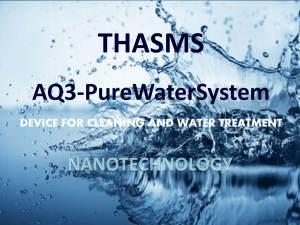Respiratory Protection
advertisement
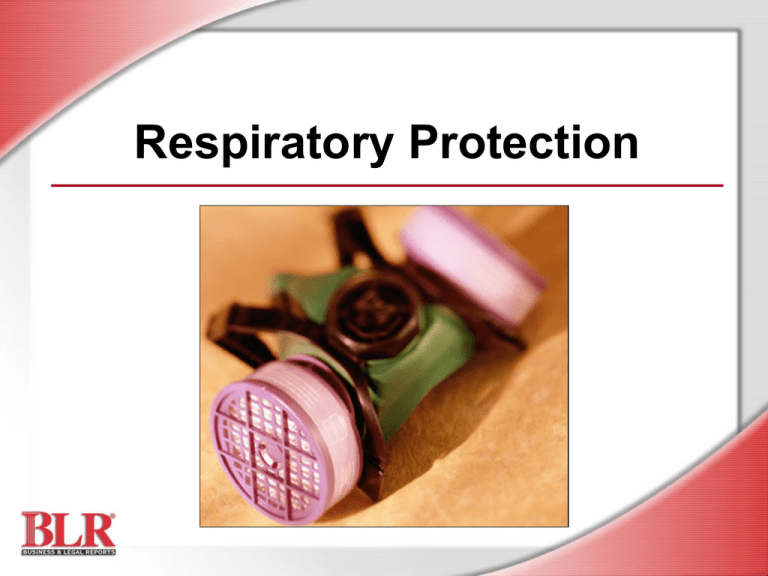
Respiratory Protection Session Objectives You will be able to: • Identify the hazards of airborne contaminants • Identify and use appropriate respiratory protection • Recognize the limitations and capabilities of respirators in our workplace • Inspect, maintain, and store respirators © Business & Legal Reports, Inc. 0812 Session Objectives (cont.) • Use respirators under dangerous or emergency conditions • Understand procedures for medical evaluations and recognize the medical signs and symptoms that may prevent effective respirator use © Business & Legal Reports, Inc. 0812 Respirator Use Locations • Locations where respirators are required • Types of airborne contaminants © Business & Legal Reports, Inc. 0812 Inhalation Hazards • Airborne particles • Dust, fog, smoke, fume, mist, aerosol • Chemical vapor or gas • Biological organisms • Bacteria, mold, spores, fungi, or viruses • Lack of adequate oxygen © Business & Legal Reports, Inc. 0812 Immediately Dangerous to Life or Health (IDLH) • Immediately dangerous to life or health (IDLH) atmosphere • Oxygen deficiency is an example of IDLH • IDLH conditions occur in confined spaces, large chemical spills, or chemical fires • Protect with a full facepiece supplied-air respirator (SAR) with self-contained air, or self-contained breathing apparatus (SCBA) • Standby person must be trained to conduct emergency rescue © Business & Legal Reports, Inc. 0812 How Respirators Work • Prevent inhalation of airborne contaminants • Generate negative pressure in facepiece • Generate positive pressure in facepiece • Air is passed through a filter, sorbent, or catalyst that traps contaminants © Business & Legal Reports, Inc. 0812 When Are Respirators Needed? • When other controls • • • • are inadequate or not feasible During installation of engineering controls During maintenance operations While performing nonroutine tasks For emergency response © Business & Legal Reports, Inc. 0812 Types of Facepieces Tight-fitting • Straps or clamps • Half face, full face, or mouthpiece • Dust mask (durable or single-use) Loose-fitting • Hood or helmet © Business & Legal Reports, Inc. 0812 Assigned Protection Factor (APF) • The minimum level of protection of a properly functioning respirator • APF 10 means one-tenth of the airborne contaminant filtered by the respirator may be inhaled • Each type of respirator must have an APF for each contaminant it filters © Business & Legal Reports, Inc. 0812 Air-Purifying Respirator (APR) • APRs are negative • • • • • pressure Simply filter the air, not supply oxygen Particulate Gas and vapor Combination Limited to non-IDLH atmospheres, maximum APF of 50 © Business & Legal Reports, Inc. 0812 Half-Face APR • Maximum APF of 10 • No protection for the face or eyes • Sight is not impaired, and no need for corrective lenses • Not as heavy as full face respirator © Business & Legal Reports, Inc. 0812 Full-Face APR • Maximum APF of 50 • Protects the face and eyes • Difficult to see when the facepiece fogs up • Difficult to speak • Requires lens correction © Business & Legal Reports, Inc. 0812 Powered Air-Purifying Respirator (PAPR) • Maximum APF 25 to 1000 • A blower forces ambient air through filter • No separate or self-contained air supply © Business & Legal Reports, Inc. 0812 Prohibited Uses of APR and PAPR • IDLH atmosphere, including oxygendeficient • Unknown airborne contaminants • Contaminants with poorly understood exposure limits or other warnings • Specific chemicals • Contaminant concentrations exceed maximum use concentration (MUC) limits • MUC=The OSHA Permissible Exposure Limit (PEL) x APF © Business & Legal Reports, Inc. 0812 Atmosphere-Supplying • Provides a separate or self-contained air supply from outside the ambient atmosphere • SAR • SCBA • Primary types are continuous flow, demand, and pressure demand © Business & Legal Reports, Inc. 0812 Dust Mask (Filtering Facepiece) • Negative pressure • Filter removes particulates (dust) • The filter is an integral part of the mask • The entire mask is composed of the filter material • Hazard protection is very limited Image Credit: OSHA © Business & Legal Reports, Inc. 0812 Escape-Only • It is intended only for emergency exit • Used mainly for IDLH atmospheres © Business & Legal Reports, Inc. 0812 Inhalation Hazards and Respirators—Questions? • Any questions about the hazards of airborne contaminants at our facility? • The types of respirators used at the facility? © Business & Legal Reports, Inc. 0812 Respirator Selection • The physical state of the contaminants • Contaminant concentration • Oxygen deficiency • Warning properties of the contaminant(s) • Potential for an IDLH atmosphere • Length of time of respirator use © Business & Legal Reports, Inc. 0812 Respirator Selection (cont.) • The workload of the wearer • The working environment (e.g., temperature) • The proper filter media for the given contaminant • Potential hazard of skin contact with contaminants • Potential hazard of eye contact with contaminants © Business & Legal Reports, Inc. 0812 Respirators for Non-IDLH Use • If cartridges have no “end-of-service-life indicator,” a change schedule must be used • Added table for oxygen-deficient atmospheres based on altitude © Business & Legal Reports, Inc. 0812 Filters, Cartridges, and Canisters • All must be labeled and color-coded with the NIOSH approval label • The label must not be removed and must remain legible • Marked with “NIOSH,” manufacturer’s name and part number, and cartridge or filter type • Matrix approval label supplied • End-of-service-life indicator (ESLI) must be NIOSH-certified for APRs © Business & Legal Reports, Inc. 0812 Respirator Filter Color Codes • Acid gas (e.g., sulfuric acid)—white • Acid gas and organic vapor—yellow • Acid, ammonia, and organic vapors—brown • Acid gas, ammonia, carbon monoxide, and organic vapors—red • Ammonia—green © Business & Legal Reports, Inc. 0812 Respirator Filter Color Codes (cont.) • Carbon monoxide gas—blue • Chlorine—white and yellow • Dust, fumes, and mists (non-radioactive)—orange • Organic vapor—black • Other vapors and gases—olive © Business & Legal Reports, Inc. 0812 Fit Test • Required for any tight-fitting facepiece before use • Ensures no contaminants leak into the facepiece • Retesting required annually, and after weight loss or dental work • No beards allowed © Business & Legal Reports, Inc. 0812 Qualitative Fit Test • Negative pressure test for APRs • Exposure less than 10 times the exposure limit • PAPRs and atmosphere-supplying in negative pressure mode • Subjective—smell or taste • Irritant smoke and ambient aerosol © Business & Legal Reports, Inc. 0812 Quantitative Fit Test • Numeric measurement—fit factor—of leakage into the respirator • Controlled negative pressure • Portacount™ • For negative-pressure APRs, exposure levels greater than 10 times the occupational exposure limit © Business & Legal Reports, Inc. 0812 Check the Seal • No facial hair or glasses are allowed that prevent a tight seal • The facepiece seal is paramount • Perform a seal check each time you put on the respirator • Conduct a positive and negative pressure check © Business & Legal Reports, Inc. 0812 Voluntary Use of Respirators • You can use your own respirator if it does not create a hazard • Read the information for voluntary users of respirators • Program for nonrequired users • No program required if only dust masks are used © Business & Legal Reports, Inc. 0812 Inspect Respirator Carefully • Inspect the respirator before each use and during cleaning, following manufacturer’s instructions • Emergency respirators • Check at least monthly when not in use • Check before and after each use • Check elastic parts for pliability and deterioration • Report any problems or defects © Business & Legal Reports, Inc. 0812 APRs—Maintain and Clean Components • Toss out dust masks • Remove filters • Wash and rinse • Carefully replace valves • Dry with cloth or air dry • Reassemble, then test © Business & Legal Reports, Inc. 0812 Store Properly • Protect equipment from damage, sunlight, or contamination • Store dry respirator and cartridges in a clean container or bag • Do not allow the facepiece to be distorted © Business & Legal Reports, Inc. 0812 Respirator Care and Use— Questions? • Any questions about your responsibilities for the care and use of respirators and their components? • Any questions about the respiratory protection plan or dangerous atmospheres? © Business & Legal Reports, Inc. 0812 Medical Evaluation • An initial medical evaluation—a questionnaire—is required before fit testing and respirator use • All medical evaluations must be confidential • Employees must be allowed to discuss the questionnaire with the physician • Follow-up evaluations must be conducted if conditions of use or user health change © Business & Legal Reports, Inc. 0812 Regulatory Requirements • 29 CFR 1910.134 • Requires a written respiratory protection plan • Employee training • Medical evaluation • Fit testing • Provide respirators at no cost to employee © Business & Legal Reports, Inc. 0812 Employer’s General Requirements • Use NIOSH-approved respirators only • Evaluate the workplace hazards • Select respirators from multiple models and sizes • Where exposure to hazards can’t be estimated, consider it as IDLH © Business & Legal Reports, Inc. 0812 Written Respiratory Protection Plan • Written operating procedures • Respirator selection, use, training, and fitting • Respirator maintenance, storage, and inspection • Work area surveillance • Medical examinations • Program evaluation © Business & Legal Reports, Inc. 0812 Additional Plan Requirements • Must be site specific • Must have a program administrator © Business & Legal Reports, Inc. 0812 What’s Wrong Here? • Worker applying trichloroethane in a confined space • Half-face respirator • Becomes unconscious • List the hazards © Business & Legal Reports, Inc. 0812 What Can Be Done? • What are the proper safety procedures to prevent exposure? © Business & Legal Reports, Inc. 0812 Key Points to Remember • Understand the physical and health hazards of dangerous airborne substances in your work area • Make sure appropriate engineering controls are implemented before using a respirator • Know how to properly don, fit, use, inspect, clean, and store respirators • Inspect respirators and cartridges before each use © Business & Legal Reports, Inc. 0812 Key Points to Remember (cont.) • Always make sure the right respirator and cartridge are matched to the appropriate working conditions and contaminants © Business & Legal Reports, Inc. 0812
